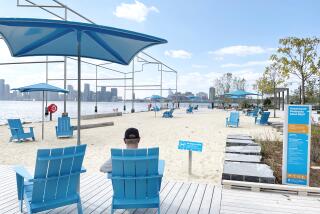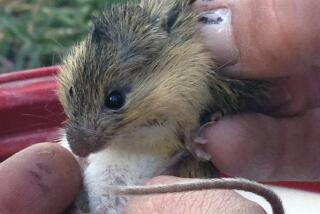Forager Steve Brill promotes living off the land, in Central Park
NEW YORK — It was hard to stand out among the crowds in Central Park on Memorial Day, but one man did as he marched into the urban oasis wearing a pith helmet and carrying a shovel and a large backpack.
As he headed down a footpath from the West 72nd Street entrance, about 20 people followed, weaving through the tourists, locals and pedicab drivers like ducklings trailing a mother duck. Minutes after entering the park, their bearded leader plunged his shovel into soil moistened by recent rain and urged others to do the same.
“Be a little discreet,” he said, an acknowledgment of the prickly relationship he has with city officials who frown on these increasingly popular foraging tours, but who rarely step in to stop the energetic man leading them: Steve “Wildman” Brill.
For more than 30 years, Brill, a 63-year-old carnivore-turned-vegetarian-turned-vegan, has led foraging expeditions through New York City parks in a campaign to improve people’s eating habits and save them from heart disease and other ills.
He has led tours as large as 78 and as small as two. “The whole world is my garden,” said Brill, whose devotion to persuading people to eat greens would seem to endear him to the city.
After all, Mayor Michael Bloomberg has pursued an aggressive campaign against poor health habits. He banned smoking in most public places and recently announced plans to outlaw sales of super-sized sugary drinks in restaurants, delis, cinemas and stadiums.
“I love the stuff he’s doing, nutritionally,” said Brill, a onetime aspiring chess master with no formal scientific training.
The city doesn’t love what Brill is doing. But the popularity of his tours seems to have left it stymied as to how to stop his groups from pulling sassafras and field garlic from the ground and plucking mulberries, Juneberries and other sweet delights from shrubs and high branches.
The city’s Parks and Recreation Department would not discuss Brill except to note that park rules make it illegal to “sever, mutilate, kill or remove from the ground” foliage under its jurisdiction.
But Neil Calvanese, vice president for operations of the Central Park Conservancy, the nonprofit that manages the park, didn’t hesitate when asked about foraging tours.
“They are bad, and they are growing. The impact to the park is tremendous,” said Calvanese, accusing foragers of upending the park’s ecosystem and undermining the work that has gone into reviving Central Park and the city’s other green spaces.
“When you came here 30 years ago, the weeds had taken over. The infrastructure had broken down,” Calvanese said. “Some of these foraging groups are taking kids into the park now, and it’s teaching them an absolutely horrible lesson: that you can go into a public park that is used by 38 million people a year and pick your salad.”
Brill says city opposition is rooted in a fear of “frivolous” lawsuits in case someone picks a poisonous mushroom or plant — something he said has never happened under his watch.
He insists that many park officials secretly admire his efforts and that this is why he hasn’t been arrested since 1986, when park officers posing as foragers came on a tour and leapt into action as Brill shoved a dandelion into his mouth. Brill said a charge of criminal mischief was dropped.
Since then, Brill has led his tours relatively unfettered. Neither he nor his followers appeared concerned about park officials as they plunged into Central Park over the sweltering holiday weekend, pouring sweat as they carted shovels, scissors and other gardening tools. Like Brill, most said they were doing something good for their health, their pocketbooks and the park, by raising awareness of what grows there.
“There’s such a tragic shortage of knowledge of what’s here and what grows wild. People just walk right past it,” said Francesca Hessler, who had filled sacks with leaves and berries and was hoping to stock up on salad greens.
“My fridge is empty,” joked Hessler, who moved to New York from Pasadena two years ago and was on her third tour with Brill. “It’s something you have to do habitually to get good at,” Hessler said.
Brill, who leads at least two five-hour tours a week between March and December, and who suggests a $20 donation, sees himself primarily as a teacher of nature. As he stops at each edible or medicinal plant, he pulls out an iPad to display pictures, points out identifying markers such as veins and leaf shapes, and embellishes his teachings with odd plant trivia.
Burdock, he said, helped inspire the invention of Velcro because of its sticky burrs. White snakeroot is toxic and was blamed for killing Abraham Lincoln’s mother, who became ill after drinking milk from a cow that had consumed the herb. The anti-inflammatory chemical in jewelweed — so-called because water forms jewel-like beads on its waxy leaves — is used in Preparation H, Brill said.
But most of his talk focuses on the tastes of plants, roots, berries and herbs and on the various ways to saute, boil, steam or merely munch them raw. Those in short supply, such as yellow watercress, he doesn’t pick. Others, such as sassafras, Juneberries and burdock, which Brill says are plentiful and easily regenerated, are yanked, snipped, picked and plucked as Brill meanders among the crowd.
Brill said his mother’s death at 57, and his family’s history of heart disease, prompted him to move away from junk food and meat and into a vegetarian lifestyle in the 1980s.
He eventually became a vegan and devotes part of his tour to urging foragers to try his cookbooks and check out his app. He met his wife when she came on a foraging tour Brill was conducting for a singles group in the late 1990s, and they have an 8-year-old daughter, who Brill said is growing up with a healthy, but not rigid, diet.
“I don’t deprive her of birthday cakes when all the other kids are having it. But we try to keep the bad stuff on the low side,” he said, defining “bad stuff” as refined carbohydrates, sugar, white flour, artificial chemicals and animal products.
Lest anyone accuse Brill of not appreciating the joy of old-fashioned comfort food, he notes that his recipes include one for chocolate truffles — thick, gooey sweets made from the beans of Kentucky coffee trees found in city parks — and a macaroni and cheese dish featuring whole grain pasta, black walnuts and grated tofu cheese.
For all Brill’s claims to be bringing people closer to nature, Calvanese said his tours overlook one thing.
“Whatever you’re eating in this park, remember, there’s 38 million people coming through. And dogs. And everything else,” he said. “I wouldn’t recommend it.”
Brill isn’t worried. “This is how our ancestors lived,” he said. “They knew what they were doing.”
More to Read
Start your day right
Sign up for Essential California for news, features and recommendations from the L.A. Times and beyond in your inbox six days a week.
You may occasionally receive promotional content from the Los Angeles Times.







